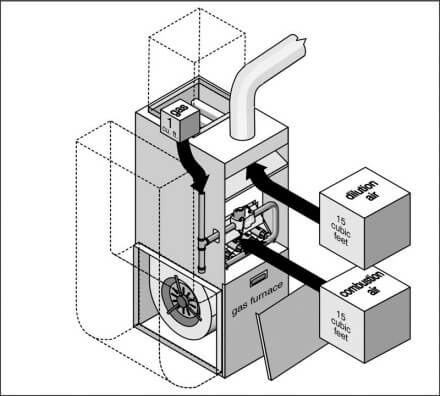Nelly has lived in the same split entry house since it was built in 1980, and has never had any moisture problems with his home until recently. Shortly after replacing his old mid-efficiency natural draft furnace with a high-efficiency furnace, Nelly started noticing a host of moisture problems with his house. It started with condensation on the windows that never used to be there. Next thing he knew, water spots showed up on the ceiling around the skylights, which were the result of excessive condensation in the attic.
Nelly called the HVAC company that installed his furnace and complained about the moisture problems he was having. A badly cracked heat exchanger could lead to moisture problems in a home, and a vent that is not properly exhausting to the exterior could also cause serious damage to the home. The installers came out and checked everything, but it was all working fine. Why is Nelly having moisture problems now?
The answer has to do with combustion air and dilution air. On a standard furnace, combustion air and dilution air are taken from inside the house. Combustion air provides the oxygen that is required for combustion, and dilution air helps to lower the temperature of the exhaust gases. When you add up the combustion air and dilution air, it equals quite a large volume of air that is constantly rising up and out of the house during the heating season.
Combustion air and dilution air get replaced with cold, dry outside air. This is part of the reason that older houses get so dry in the winter. Is this starting to make sense?
High efficiency furnaces save energy by taking combustion air directly from the exterior, rather than wasting the heated air in your home for combustion. When Nelly replaced his natural draft furnace with a high efficiency furnace, he stopped wasting all that warm, moist air. In reality, the high efficiency furnace didn’t ‘create’ the moisture problem; it just replaced a less efficient furnace that was helping to prevent a problem.
In order to address the moisture problems in his home, Nelly has a few options. He could install a continuous exhaust fan to constantly remove air from the home, but this obviously wouldn’t be a very Green thing to do, because all of that warm air would always be replaced with cold air. Nelly could run dehumidifiers all winter, but again, this would be expensive. Nelly’s best option would be to install a heat recovery ventilator (HRV). An HRV will constantly change out the air in the house while at the same time removing humidity from the house.
Reuben Saltzman, Structure Tech Home Inspections

